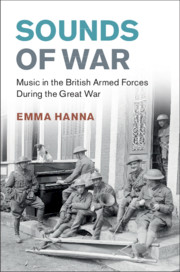Book contents
- Sounds of War
- Studies in the Social and Cultural History of Modern Warfare
- Sounds of War
- Copyright page
- Dedication
- Contents
- Figures
- Acknowledgements
- Abbreviations
- Introduction
- 1 Music in Britain, 1914
- 2 Recruitment and Fundraising
- 3 Instruments of War
- 4 Songs, Identity and Morale
- 5 Captivity
- 6 Religion and Pastoral Care
- 7 Medicine and Therapy
- 8 The Gramophone
- 9 Civilian Concert Parties
- 10 Servicemen’s Concert Parties
- 11 After the Armistice
- Conclusion
- Notes
- Sources and Select Bibliography
- Index
3 - Instruments of War
Published online by Cambridge University Press: 20 February 2020
- Sounds of War
- Studies in the Social and Cultural History of Modern Warfare
- Sounds of War
- Copyright page
- Dedication
- Contents
- Figures
- Acknowledgements
- Abbreviations
- Introduction
- 1 Music in Britain, 1914
- 2 Recruitment and Fundraising
- 3 Instruments of War
- 4 Songs, Identity and Morale
- 5 Captivity
- 6 Religion and Pastoral Care
- 7 Medicine and Therapy
- 8 The Gramophone
- 9 Civilian Concert Parties
- 10 Servicemen’s Concert Parties
- 11 After the Armistice
- Conclusion
- Notes
- Sources and Select Bibliography
- Index
Summary
Moves with the military bands, pipes, drums and buglers to the fighting fronts. It will show the practical uses of music in the field and on board ships as an important marker for servicemen’s daily schedules. This section will also outline musicians’ roles in battle. It will show that while Bandsmen in regular infantry units often acted as stretcher bearers, those who enlisted from August 1914 and served in Territorial battalions did a great many other jobs. It will also show that the formation of bands was driven largely by the men themselves.
- Type
- Chapter
- Information
- Sounds of WarMusic in the British Armed Forces during the Great War, pp. 53 - 75Publisher: Cambridge University PressPrint publication year: 2020
- 1
- Cited by

